Vol. 42, #2, Summer 2024
"Cap" Beesley Straight Talks Gems and Minerals
- Home
- Newsletter
- Vol. 42, #2, Summer 2024
"Cap" Beesley Straight Talks Gems and Minerals
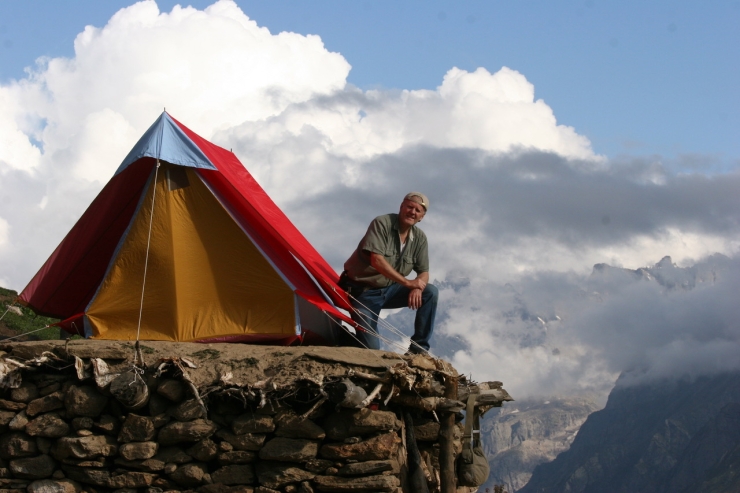 |
| C.R. “Cap” Beesley in Indian Kashmir, designated by Rapaport Magazine as “The Kashmir Legend” |
C.R. "Cap" Beesley is one of the most fascinating and influential people in the gem world. He really doesn't need an introduction. AGL under Cap was always seen as a consumer lab, not a dealer lab. Cap felt the more detailed, accurate, and quality information a collector had about a stone they were considering, the better their decision would be. Regretfully, most labs today put very minimal information on their grading reports, to the detriment to the inexperienced collector.
Gemstone Forecaster (GF): Seems hard to believe you left AGL approximately 15 years ago. Any plans to start a new lab?
15 years is a long time to be detached from the actual day-to-day operations of an international gem lab. However, the transition has allowed me to explore a whole range of new alternatives connected to gemstone analysis.
Although I was offered several opportunities to develop new gem testing facilities, especially in the Far East, I have concentrated my activities on exploring, adapting, and developing new concepts that support our original AGL focus of servicing the interest of gemstone buyers and protecting consumers. This was always the
primary objective of the policies that predated the current administration of AGL.
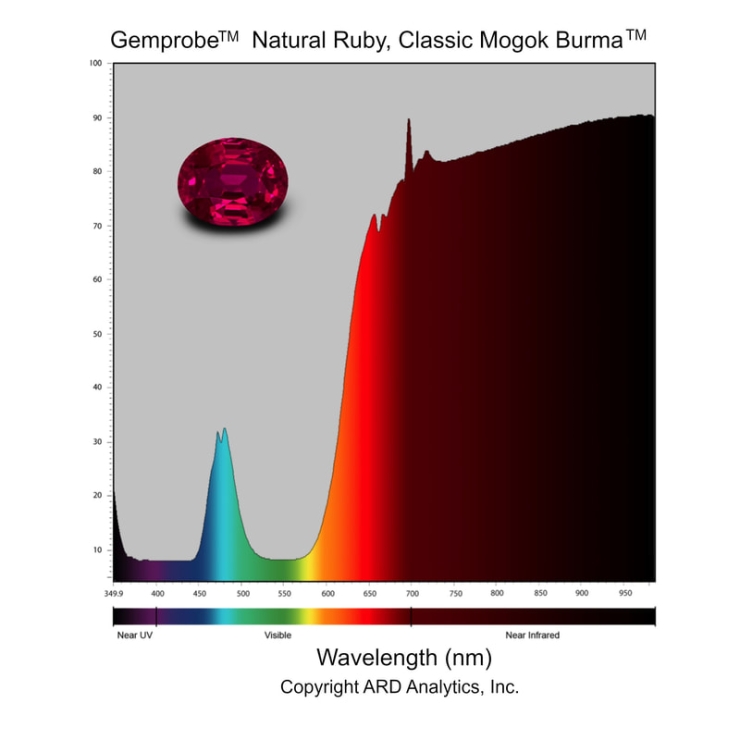 |
| Analytics R&D explored multiple high tech devices from photo acoustic spectroscopy to optical emission spectrometry to improve gem testing procedures. |
Most people are probably unaware that prior to establishing American Gemological Laboratories, I developed Analytics Research and Development, Inc. a company focused on generating analytical procedures and methodologies to enable gem testing to be more efficient and consistent. Part of the focus of Analytics was to explore the technology available in other industries that had potential applications in gem testing and adapt those techniques to gemstone analysis. Many of these discoveries were modified, redesigned and integrated into the lab procedures of the original AGL.
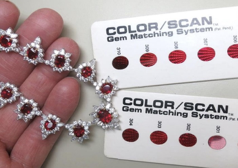 |
| Color grading Burma Rubies using Color/Scan, the award winning color communication tool created by Analytics R&D which was promoted and used by the original AGL |
Our R&D program spanned a broad range of simplified, but effective, analytical techniques that included high efficiency spectral analysis as well as Color Scan, the ultimate, award winning colored stone grading tool, as well as developing an adaptation of NASA's laser ablation technology designed for space bound Rovers. The results were a series of patents and procedures that, in many cases, streamlined gemstone analysis and enabled us to provide documents that were informationally more effective than our competitors and highly beneficial to gemstone consumers.
In addition, I have engaged in a host of other gem, mineral, and museum projects since my departure from AGL. Currently we have generated a new series of devices and visually exciting three-dimensional document options that will support our ongoing gem consumer protection agenda that has always been the foundation and focus of our technological pursuits.
In the final analysis, it is my opinion that long-term solutions to pending and emerging issues in the gemological world will not be satisfied by just another lab. The key to change is developing mechanisms to challenge existing labs to be more responsive to consumer interest. This will require a procedural shift in both priorities and practices by existing gem labs.
GF: Are you concerned with the lack of quantified grading of most laboratories today? For example, are you concerned many labs simply put "pigeon blood" on any slightly red ruby?
It is an unfortunate fact of life in the world of international gemological laboratories that independent policy decision-making by these labs is fundamentally nonexistent. Basically, most labs cater to the dealer population that form their client base or that sit on their governing boards. The labs will probably vehemently deny that this is how the system operates, but a review of the decisions executed by the labs as reflected in their reports, especially relative to enhancement disclosure or meaningful grading information has been painfully slow to non-existent. Unfortunately, most real change in gem lab policy, or gem and jewelry association positions that ultimately provided transparency to gem consumers has been primarily stimulated by media exposés.
To the best of my knowledge, the original AGL. during my entire presidency, was the only international gem lab that did not accept a single dollar of dealer or retailer funds as part of its funding base at any point in its history. In addition, we were never obligated to any organization, entity, or group. In fact, we did not even entertain dealers on a governing board or in any administrative capacity. The history of bad lab decision-making is littered with examples of poor policies that benefited dealers at the expense of consumer protection. That does not mean there were not excellent and qualified gemologists on the staffs of these organizations that had to swallow hard in order to implement the misguided policies dictated by their governing boards or gem lab administrators. Privately, they would share with me that they envied our independence and tenacious pursuit of consumer protection policies.
A classic example of an international problem was that dealer associations and laboratories had to be dragged into the disclosure of heat treatment in sapphires when the process was in many cases easily identifiable.
This introduction is a preface to your question regarding colored stone grading in laboratories and what has continued to happen since my departure from AGL. One of the most egregious examples is the issue of using ill define terms to promote the marketability of primarily ruby, emerald, and sapphire.
For example, "pigeon blood," a common descriptor in many of today's gem lab reports is currently to rubies what "blue white perfect" was historically to the diamond trade… It's all smoke and mirrors. For those that are unfamiliar with the "blue white and perfect" terminology, that phraseology dominated diamond sales counter jargon for years and the public was trained to believe that it was the best of the best. The current buzzwords like "pigeon blood" have enjoyed the same misguided popularity as "snake oil" by the roaming salesman of the old west that claimed they had a cure all for everything that ailed you.
For the record, I have viewed and documented rubies at the AGTA Tucson Convention Center shows on multiple occasions where dealers displayed a whole population of red range colors all being classified as "pigeon blood" on reports produced by recognized labs. Unfortunately, the people of China, along with many other countries, including the US, have succumbed to the marketing term that translates into a meaningless descriptor of rubies. It is basically a shallow attempt at grading color to convince consumers that they are buying the best without any real regard for the original application of the term. The phrase is used without any consideration for all the other grading factors that define the overall quality of a gem ruby.
For reference, at one point, I had a private viewing at Christie's of a very prominent person's jewelry. The showing was personally administered by a high-ranking individual at the auction house. In a private moment, I queried the individual about the reliability and usefulness of the phrase "pigeon blood." He promptly responded without hesitation that it is all "marketing hype." Based on observations, "pigeon blood" applies to a broad swath of ruby colors.
I understand the term was being used on documents without any connection to a recognized reference standard that was universally defined by anyone. The saga of funky names continues with additional terms like "Royal Blue" and "Muzo Green." My recommendation is to avoid reliance on any of these terms unless and until they reflect a meaningful standard based on known, definable, and reproducible reference points.
GF: How active are you with Yale Peabody Museum? Purchase anything interesting lately?
Beyond gemstones, one of my primary interests is in the world of minerals, especially as they relate to the natural history museum environment. Many of our AGL clients were probably unaware that we actively analyzed and graded minerals for important collections that are currently on exhibit in the collections of The Peabody Museum at Yale and the Museum of Natural History in New York. Aside from serving on the original Board for the University of Arizona Museum in Tucson, my primary museum focus has been the Peabody. A number of years ago I was asked to join Yale's Leadership Council for the museum. The council is a brain trust that provides assistance to the museum and its staff in a variety of areas. It is quite an impressive group of individuals that I thoroughly enjoy interacting with during our twice a year full day meetings. It is quite a combination of influential people that includes individuals like Ed Bass, who put up the first $160,000,000 to renovate the entire museum that began just before the covid pandemic. Shawn Levy, director of the "Night at the Museum" film series has contributed his skill set to several Peabody projects. One of the recent additions to the council is Dr. Kirk Johnson, The Sant Director of the Smithsonian Institution in Washington, DC.
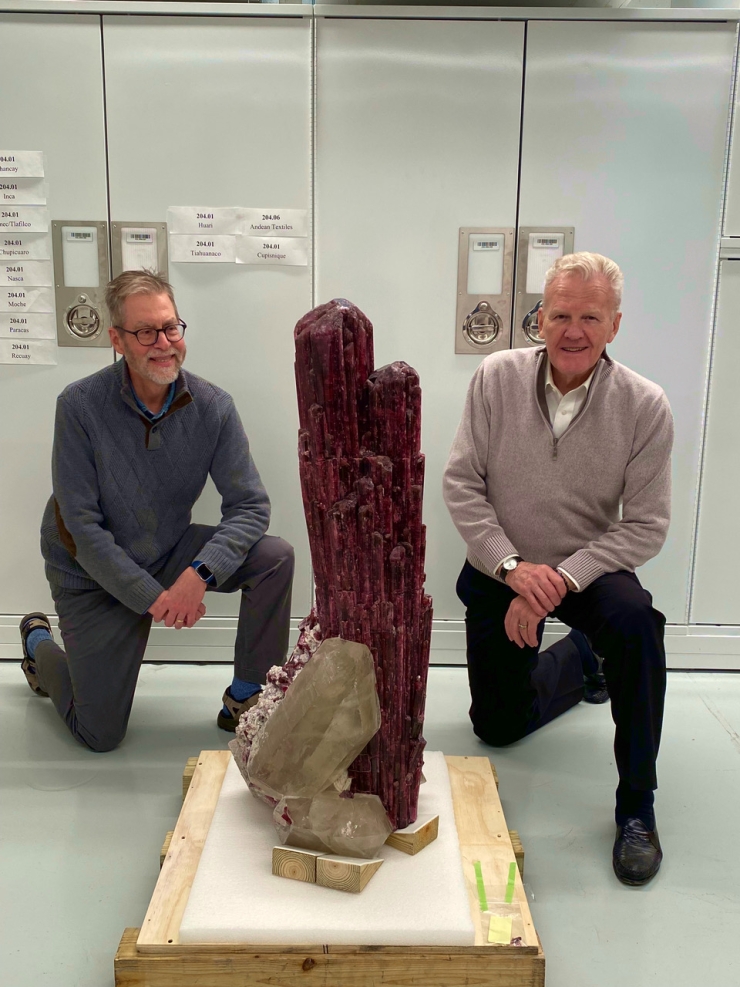 |
| A centerpiece of the Mineral Hall is the 42 in. Rubellite crystal from the famous Jonas Pocket in Brazil. Pictured with Dr. Jay Ague, curator of the collection and C.R. “Cap” Beesley, Chair of the Mineral Advisory Board |
The person who was instrumental in changing and expanding the importance of the Peabody Museum's gem and mineral area was David Friend, a 1969 graduate of Yale in electrical engineering and the one time president of Carbonite. Currently he serves as the president of Wasabi, an important online storage facility. He funded the now famous David Friend Hall of Minerals. At the outset of this project the Peabody's director and David Friend requested that I go to China to acquire important minerals to anchor the new mineral hall. Several important specimens were acquired.
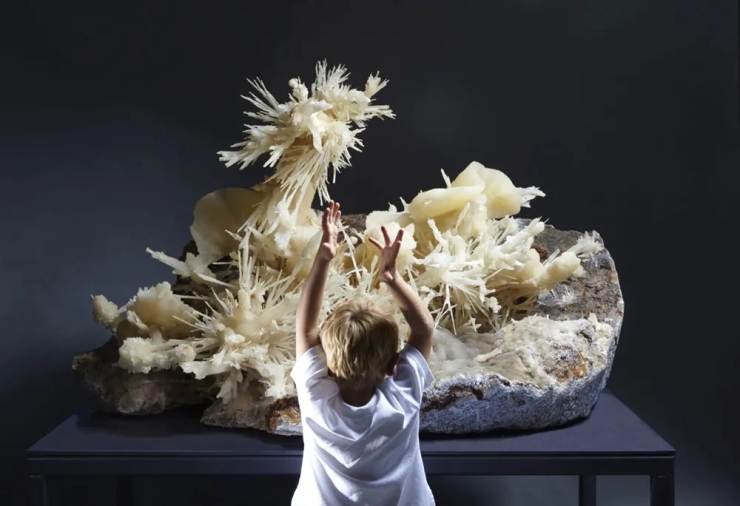 |
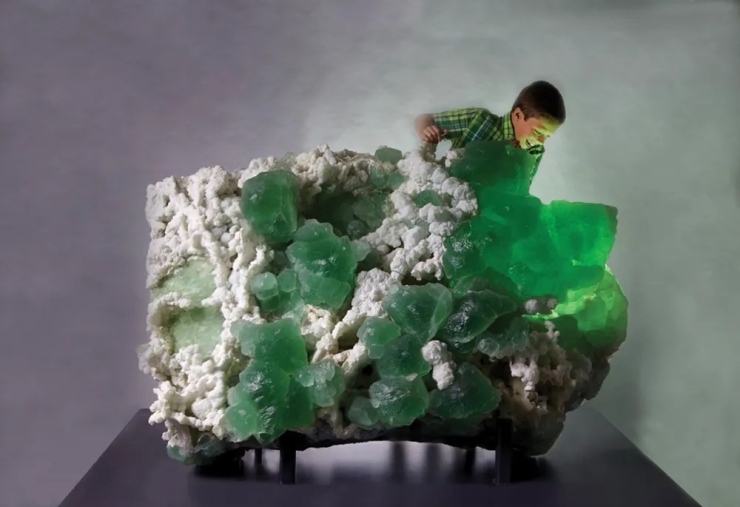 |
|
A spectacular Aragonite from China |
A phenomenal 3,300 lb. Fluorite and Quartz specimen from China Photo Credit: Robert Lorenz |
The spectacular Aragonite and the Green Fluorite with Quartz pictured in the above images are classic examples of Chinese minerals. The massive Namibian Quartz at the entrance to the David Friend Hall, was actually negotiated while I was sitting in the plane on the tarmac at JFK waiting to depart for China to search for other materials. The Aragonite is one of the centerpieces of the entire hall. The green fluorite weighs in at approximately 3,300 pounds and is a phenomenal example of Chinese fluorites.
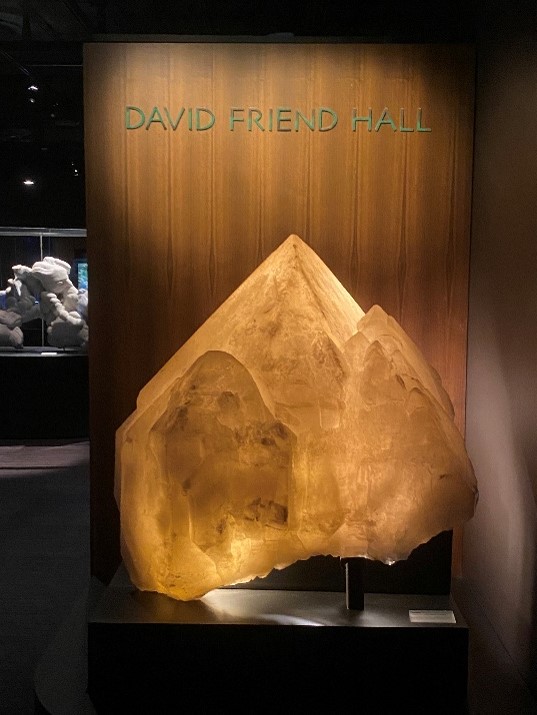 |
| The massive Namibian Quartz at the entrance to the David Friend Hall of Minerals |
As part of my activities at Yale, I was asked to chair the Gem and Mineral Advisory Board for the Peabody. I have served in that position for a number of years and enjoy interacting with a talented and focused staff at the museum that is now creating a world-class exhibition of minerals from around the world, along with one of the finest gold exhibits on display at any museum in the country. Developing connections with donors and loaners to the museum has resulted in a spectacular array of some of the finest specimens in the world
As part of the extraordinary interest in the gem and mineral area, Yale also sponsored a series of informational gem and mineral symposiums. I presented a gemstone trilogy that focused initially on Kashmir Sapphire, then Burma Ruby, and finally on Emeralds from around the world. We are now preparing for the grand opening of the gem and mineral sector of the $200 million renovation of the entire museum. Many of the mineral specimens are from one of the most important private collections in the world amassed by the late founder and visionary of The Mineral Trust, Mr. Barry Yampol. I continue to search for individuals and companies that share the vision of Mr. Yampol to assemble and preserve important collections of gems and minerals for future generations to enjoy, appreciate, and study.
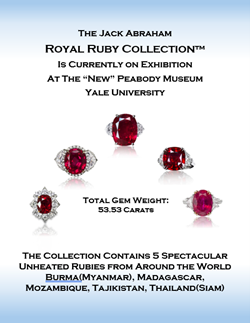 |
In addition, we have had important gem dealers like Jack Abraham of Precious Gem Resources become one of the Peabody's most prolific and consistent supporters in the gem and jewelry sector. Recently, he provided one of the major highlights in the gem section called the Royal Ruby Collection™. It is a group of five gem rubies weighing a total of 53.53 carats. Each one of these Rubies is from a different geographic location. The multi-million dollar display is making its debut at the upcoming Grand opening of The Peabody's Gem and Mineral Hall.
GF: What is happening in the mineral business? Prices have been escalating dramatically, correct?
The mineral world has been subjected to the same economic trauma as the gem business. Logic has failed and prices have been elevated to unreasonable levels that are crushing the critical middle world of collectors that historically has been the bread and butter of mineral economics. There are a number of factors that have influenced the dramatic escalation of prices in the mineral world. Individuals with unlimited funds have ventured into an era that merges minerals with an art world mentality. Too often these high-end buyers have the funds but unfortunately lack insight and understanding regarding the details of mineral acquisition. As a result, they buy into the hyperbolic jargon that pushes price as the ultimate measure of acquisition value rather than meaningful quality principles and accurate descriptions. At times, some sellers even resort to using museum curators to reinforce the confidence of potential buyers that the elevated dollar values are justified.
In an industry devoid of adequate enhancement and alteration disclosure policies, it frequently parallels the gem industries dark side regarding the failure to disclose alterations to the materials that have been used at times to dramatically enhance specimens. Modifications include everything from fracture and luster enhancements to reconstruction of damaged crystals, especially to terminations. At times crystals are painstakingly added to a specimen to enhance the balance and subsequent aesthetics and, therefore, the ultimate value of a specimen. This is not to suggest that this happens in every case. As in gems, there are minerals that are truly beautiful and unique without any manipulation, and as in the case of gems they are worthy of a premium price. However, not unlike the gem business, the motivation to manipulate and mis-represent is an ever present danger.
Full disclosure should be the order of the day without exception. A positive and unambiguous statement on an invoice that the material has not been subjected to any manipulation or modifications, guarantees to the buyer that the specimen is free of enhancement or alteration. On the other hand, if alterations have been made, they should be clearly identified in detail on the invoice.
I think there is a distinct possibility that a realignment of prices may be coming down the pike. However, international currency instability may be a deterrent to pricing adjustments in the near future.
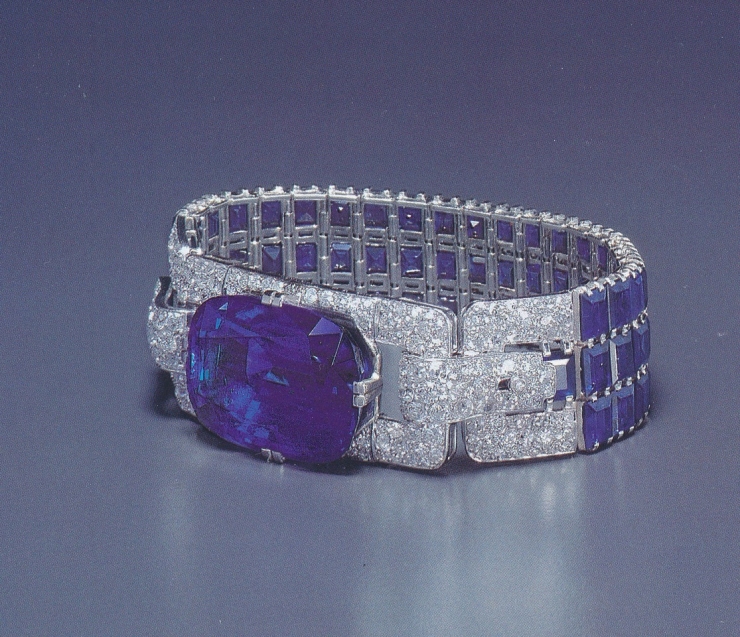 |
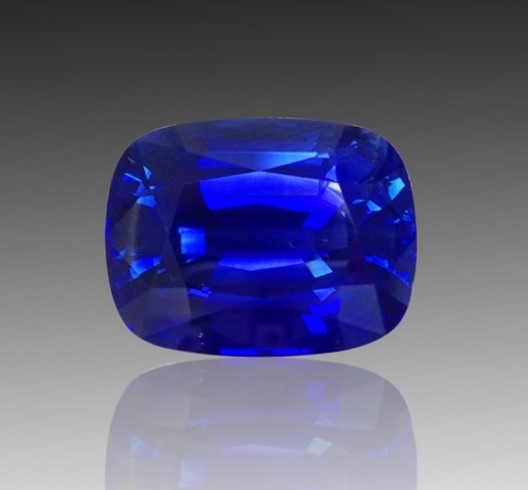 |
| The 65 carat Kashmir Sapphire in the Cartier bracelet |
The 65 carat gem Kashmir Sapphire after being recut to its current weight of 56 carats |
GF: Are you involved in any legal cases as an expert witness you can comment on publicly?
Providing consultations and documentation in legal matters has been an important function of Analytics in recent years. The company has always been extremely selective in pursuing cases that have valid and unambiguous claims. One of the most important cases involved the 65 carat Kashmir Sapphire in a Cartier bracelet that vanished during a pre-auction exhibition in Milan Italy in 1996. The theft occurred in a room full of potential clients and was the prime jewelry item at that Antiquorum auction. We were engaged by four different law firms over a five year period that involved complex legal interactions. The case has reportedly been resolved and the thieves have been identified as a crew that has specialized in gem and jewelry heists in both Europe and the United States.
Interestingly, the history of the case reads like a novel replete with international intrigue and a shadowy underground that encompassed players in Milan, Morocco, Croatia, Paris, Bangkok, and New York. The 65 carat gem was re-cut twice, first to 59 carats, and then to its current weight of 56 carats. The gemological challenge was to substantiate that the 65 carat and ultimately the 56 carat stone were one and the same gem that was originally stolen at the Antiquorum event.
Technical challenges at this level are not designed for the gemologically faint of heart. In the final analysis, the comprehensive Analytics reports establish beyond any shadow, wavering, or doubt that the 65, 59, and 56 carat Kashmir were the same gem, having transitioned through the underworld that exists on the dark side of the gem business.
Another case, dealt with the challenge of color alteration of an important Padparadscha Sapphire while in the care and custody of the GIA's California testing facility. In addition, there are also very involved cases that require the mathematical reconstruction of dimensions and weights of high-end crystals and gems from two dimensional images captured several years prior to the theft. This project also involved tracking the production of material from other countries and providing a foundation for a $200,000,000 plus loss of important Collector Level material. These kinds of projects frequently required a reevaluation of many of the basic provisions of existing gem pricing mechanisms available to the trade. All these projects required developing procedures that could stand the test of legal scrutiny in a court room.
GF: What was your opinion of the 2024 Tucson gem shows?
There is no question that the Tucson experience has changed dramatically from the days when the camaraderie and focus of Tucson was dedicated primarily to minerals and gems and less about the politics, show rivalry and the legal wranglings of wannabe promoters. There was a predictability as well as excitement that was core to the stability of Tucson events. I recall preparing an article during the beginning of this transition several years ago entitled "Sayonara Tucson… the Beginning of the End."
Now, confusion and political wrangling are an unfortunate part of the theme of Tucson. Shows and dealers are now scattered to the four winds and even the Convention Center Retail Show is a shadow of its former glory primarily due to political posturing that disregarded the interests of ultimate gem and mineral buyers that flooded into Tucson, flush with cash and anticipation, looking for the next new thing that they could add to their inventories or collections.
Today's Tucson is now populated by real estate owners that have developed their own showrooms, many of which operate year round. Mineral City is now one of the prime go-to places for mineral acquisition. The Inn Suites, a one time centerpiece of activity, has faded into oblivion, along with many other hotels that once bustled with business. Now, these classic locations have become part of Tucson's mineral past. Many of these iconic sites have joined the rubble of the Desert Inn that was once a symbol of the Tucson mineral experience.
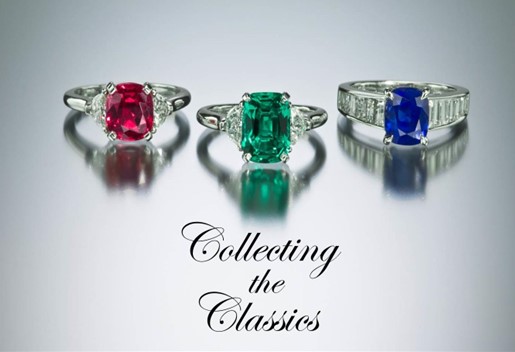 |
| Ruby, Emerald, and Sapphire are still the foundation of recognized classics |
GF: You have been pretty spot on gemstone prices over the years. What gemstones or diamonds would you recommend for today's Collectors?
Regarding your final question, let's consider what history has actually taught us about gem and mineral acquisitions. From a personal standpoint, I have functioned as a consulting gemstone specialist on call to go to Burma and Thailand at a moment's notice. My function was to authenticate and negotiate materials of importance on behalf of several prominent clients from Lichtenstein to Los Angeles. Knowledge, experience, homework and a deep dive into the marketplace are necessary keys to a successful venture especially when pursuing high-end materials. I can say with confidence that substantial profits were made for these individuals and firms based on a cautious assessment of every transaction. Like any other acquisition it is important to carefully weigh all the options to minimize the risk involved in this nontraditional mechanism.
Even dealing with auction houses, in some situations, is risky business. It's not about the name of the auction house that is singularly important. It is about the auction house's plan to deliver meaningful results that favor you as the seller and not a potential behind-the-scenes buyer that expects an edge from their friends in the auction process.
In general, it is always advisable to acquire the "best in class" of any gem type. Depending on your resources a three, five, or ten carat gem might be your limit. Do not compromise on any weaknesses in the material at the time of acquisition. These issues will be the leverage used against you at the point of resale. Regardless of your relationship with the seller, a clear cut and ambiguous statement of enhancements regarding any acquisition is obligatory and should be stated without ambiguity. If the seller indicates "no enhancements/treatments," have them put it in writing on the invoice. For example, if the laboratory says "no evidence of treatment" especially on emeralds and other gem categories like Paraiba Tourmalines, the client should demand, as a condition of the sale, the material be "soaked" in an appropriate laboratory grade solvent for at least 48 hours to confirm the following statement, "Clarity Enhancement: None." The big three, ruby, emerald, and sapphire still dominate the gemstone landscape, but caution is the order of the day. Build into a transaction as many precautionary options as you can to protect your interest. Happy Hunting.
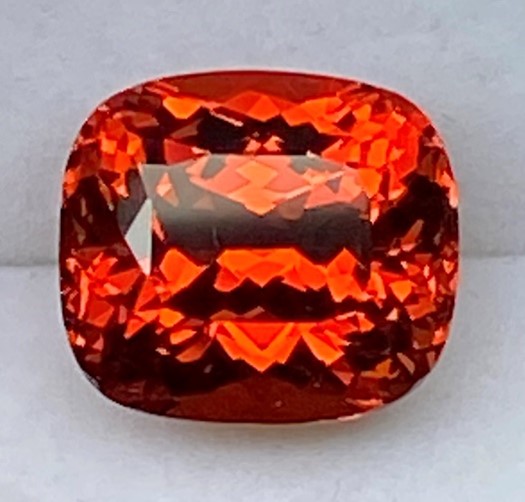 |
| A 20+ carat gem Spessartite Garnet |
There are also alternative stones that occur in similar color ranges to the big three. For example, green garnets, from Tsavorites to Russian Demantoids, tend to be clean, bright, and can be a very intense green. At the right price, they can be an interesting option. Untreated Rubellite Tourmaline is another example of a "red" family gem that has long-term potential especially in larger sizes. Even Spessartite Garnets from the intense orange family of gems have enjoyed significant popularity and price appreciation. In many cases, new materials come in waves and timing is essential from an acquisition and potential appreciation standpoint.
GF: Closing Comments?
Actually, it has been an exciting 15 year adventure that has allowed me to apply my God-given skill set to a whole new array of options and applications. I still enjoy gems and minerals as well as the technological aspects of gems as much as I ever did in spite of the changes in the marketplace. We continue with a focus on the future.
GF: Thanks Cap. Always enlightening talking with you.
The information provided in this newsletter has been derived from research and sources believed to be reliable. However, no
guarantee is expressed or implied as to their validity. Opinions included herein are subject to change without notice. The gem
market is speculative and unregulated. Certification does not eliminate all risks associated with the grading of gems.
Recommendations are meant for those who are financially suited for the risks involved. Past performance is not a guarantee of future performance. Neither NGC nor The Gemstone Forecaster guarantee a profit or that losses may not be incurred as a
result of following its recommendations. They may also hold positions in areas they recommend. Subscribers should not view this publication as investment advice, nor is it intended as an offer or solicitation with respect to the purchase or sale of any security.